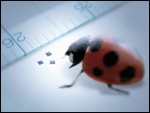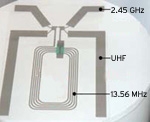Mar 15, 2004Toppan Forms, a technology subsidiary of Japan's Toppan Printing, has teamed with Kanazawa, Japan-based integrated circuit manufacturer FEC to create an RFID microchip that can operate at all frequencies from 13.56 MHz to 2.45 GHz.
Most governments around the world allow high-frequency RFID systems to operate at 13.56 MHz. But ultra-high frequency (UHF) systems range from 868 MHz in Europe to 915 MHz in the United States and 956 MHz in Japan. Some countries do not allow RFID systems to operate in the UHF band at all. Toppan's aim for its MM chip is to make it possible for companies to use tags that can be read anywhere, regardless of local regulations.
"This is the first chip that can literally be used in RFID transponders anywhere in the world," says Mitchell Shinozaki, general manager of Toppan Forms operations in the United States. "That opens up many applications. For instance, you could use it in airline baggage, and the tag could be read regardless of which frequencies are used in the countries the bag travels to."
The write-once passive chip measures 0.5 sq. mm and has 32 bytes of memory storage. The chip uses a proprietary method of communication between the tag and reader, so it cannot be read by EPC or ISO readers. Unlike most RFID chips, which are tuned to one frequency for reading and writing, the MM chip can be read by a special reader developed by Toppan using any frequency. Data is written to the chip using the infrared portion of the electromagnetic spectrum.
The MM chip can store an a 64-bit or 86-bit Electronic Product Code, and Shinozaki says the Auto-ID Lab in Tokyo, Japan, will propose that EPCglobal, the nonprofit organization set up to commercialize EPC technology, endorse the MM chip's communication specification as being EPC-compliant.
The MM chip has an antenna that is affixed to the chip itself. This antenna can operate at 2.45 GHz (a frequency commonly used in Japan because, until recently, there was no part of the UHF spectrum allocated to RFID). At 2.45 GHz, the chip can be read from 2 to 3 mm (0.08 inches).
Toppan can also add a small "booster antenna" and/or external antenna to increase the read distance. The booster antenna increases the read range to 24 to 30 cm (9.5 to 12 inches) and an external antenna extends the range to about 50 cm (20 inches).
At 13.56 MHz, the transponder can be read from 15 to 20 cm (6 to 8 inches) away with a booster antenna and from 30 to 40 cm (12 to 16 inches) away with an external antenna. In the UHF spectrum, a transponder with the MM chip can be read up to 1 meter (3 feet) away with the booster antenna and up 5 meters (15 feet) away with an external antenna.
To achieve the maximum read distances at the three common RFID frequencies (13.56 MHz, 868 to 956 MHz and 2.45 GHz), the chip needs to have the onboard antenna and two external antennas attached. Each antenna is tuned to work in one frequency range.
The MM chip will be available in commercial quantities this fall. Shinozaki says the chip alone will sell for below 10 yen (9 U.S. cents) for purchases of 10 million units or more. Toppan will sell both chips and finished RFID transponders. The transponders will be around 20 yen (18 cents) with the booster antenna and 30 yen (27 cents) with the external antenna.
The company projects 2 billion yen (about US$18 million) in sales of RFID tags and tag systems using the new chip in the first 12 months the product is on the market. Toppan will be the exclusive seller of the MM Chip in Japan. Details of how the chip will be marketed outside of Japan have not been finalized.
Toppan believes there will be a market for the product on items that travel among countries in different regions of the world. There could also be applications where the item is tracked differently as it moves through the supply chain. For instance, UHF readers might be read bulk pharmaceutical bottles arriving in cases at a warehouse. But 13.56 MHz readers might read the same tags when the bottles are placed on smart shelves.
Attend RFID Journal Live! 2004
Executive Conference, Chicago, March 29 to 31
It's Where RFID Is Happening
Register Today



